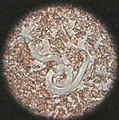Nematode
Nematodes or roundworms belong to the phylum Nematoda. They are a diverse animal phylum inhabiting a broad range of environments. Nematode species can be difficult to distinguish, and although over 25,000 have been described, of which more than half are parasitic, the total number of nematode species has been estimated to be about 1 million.
Anatomy[edit]
Nematodes are small, slender worms: typically about 5 to 100 µm thick, and 0.1 to 2.5 mm long. The smallest nematodes are microscopic, while free-living species can reach as much as 5 cm, and some parasitic species are larger still, reaching over a meter in length.
Life cycle[edit]
Nematodes follow an eutely pattern of development. The young nematode hatches from an egg. Most nematode species are dioecious, with separate male and female individuals, though some, such as Caenorhabditis elegans, are hermaphroditic.
Ecology[edit]
Nematodes play crucial roles in the soil ecosystem. They are ubiquitous in marine, freshwater and terrestrial environments, where they often outnumber other animals in both individual and species counts.
Parasitism[edit]
Many nematodes are parasitic, living inside the bodies of animals or plants. The parasitic nematodes include roundworms, hookworms, and pinworms.
Research[edit]
The nematode Caenorhabditis elegans is one of the most important model organisms in modern biomedical research.
See also[edit]
|
|
|
Nematode[edit]
-
C. elegans Goldstein Lab UNC
-
Eophasma jurasicum
-
C. elegans wt nhr80rnai
-
Hookworms
-
Gravid adult female Nippostrongylus brasiliensis
-
Anisakids
-
Threadworm
-
Microfilaria
-
Nematode Steinernema feltiae
-
Nematode Steinernema Feltiae with size comparison of 1 EURO coin
-
Tropical Diseases - Fig 149
-
C. elegans male
Ad. Transform your life with W8MD's Budget GLP-1 injections from $75


W8MD offers a medical weight loss program to lose weight in Philadelphia. Our physician-supervised medical weight loss provides:
- Weight loss injections in NYC (generic and brand names):
- Zepbound / Mounjaro, Wegovy / Ozempic, Saxenda
- Most insurances accepted or discounted self-pay rates. We will obtain insurance prior authorizations if needed.
- Generic GLP1 weight loss injections from $75 for the starting dose.
- Also offer prescription weight loss medications including Phentermine, Qsymia, Diethylpropion, Contrave etc.
NYC weight loss doctor appointmentsNYC weight loss doctor appointments
Start your NYC weight loss journey today at our NYC medical weight loss and Philadelphia medical weight loss clinics.
- Call 718-946-5500 to lose weight in NYC or for medical weight loss in Philadelphia 215-676-2334.
- Tags:NYC medical weight loss, Philadelphia lose weight Zepbound NYC, Budget GLP1 weight loss injections, Wegovy Philadelphia, Wegovy NYC, Philadelphia medical weight loss, Brookly weight loss and Wegovy NYC
|
WikiMD's Wellness Encyclopedia |
| Let Food Be Thy Medicine Medicine Thy Food - Hippocrates |
Medical Disclaimer: WikiMD is not a substitute for professional medical advice. The information on WikiMD is provided as an information resource only, may be incorrect, outdated or misleading, and is not to be used or relied on for any diagnostic or treatment purposes. Please consult your health care provider before making any healthcare decisions or for guidance about a specific medical condition. WikiMD expressly disclaims responsibility, and shall have no liability, for any damages, loss, injury, or liability whatsoever suffered as a result of your reliance on the information contained in this site. By visiting this site you agree to the foregoing terms and conditions, which may from time to time be changed or supplemented by WikiMD. If you do not agree to the foregoing terms and conditions, you should not enter or use this site. See full disclaimer.
Credits:Most images are courtesy of Wikimedia commons, and templates, categories Wikipedia, licensed under CC BY SA or similar.
Translate this page: - East Asian
中文,
日本,
한국어,
South Asian
हिन्दी,
தமிழ்,
తెలుగు,
Urdu,
ಕನ್ನಡ,
Southeast Asian
Indonesian,
Vietnamese,
Thai,
မြန်မာဘာသာ,
বাংলা
European
español,
Deutsch,
français,
Greek,
português do Brasil,
polski,
română,
русский,
Nederlands,
norsk,
svenska,
suomi,
Italian
Middle Eastern & African
عربى,
Turkish,
Persian,
Hebrew,
Afrikaans,
isiZulu,
Kiswahili,
Other
Bulgarian,
Hungarian,
Czech,
Swedish,
മലയാളം,
मराठी,
ਪੰਜਾਬੀ,
ગુજરાતી,
Portuguese,
Ukrainian












